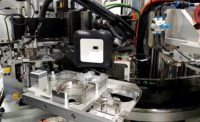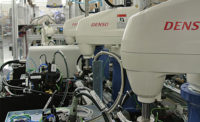Transmission manufacturing requires several high-precision tasks. This is not news to Škoda Auto, a Czech automobile manufacturer founded in 1895 as Laurin & Klement. Headquartered in Mlada Boleslav, Czech Republic, the company was acquired by Škoda Works in 1925 and became a wholly owned subsidiary of the Volkswagen Group in 2000.
From 1908 to 2012, Škoda’s plant in Vrchlabi produced bodywork for vehicles, as well as complete automobiles. The first model assembled there was a Škoda Tudor, followed by many other models, including rare special editions, and luxury and utility vehicles.
In early 2011, Volkswagen decided to convert the 1,000-employee plant into one that strictly assembles the innovative DQ 200 direct-shift-gearbox automatic transmission. This seven-speed transmission is used in Škoda vehicles, as well as models from other group brands. Production began in October 2012 at the rate of 1,000 transmissions per day, but increased to 1,500 units by the end of 2013.
Last year, the plant added a collaborative robot—the LBR IIWA 7 R800 robot from KUKA Robotics Corp.—to work alongside assemblers. According to Michael Oeljeklaus, production director at Škoda, the robot’s sole task is inserting the gear actuator piston into the transmission. Piston insertion is a delicate process that requires pinpoint accuracy.
“What was once a complicated production step for our employees [is] significantly easier and safer,” says Oeljeklaus. “By using the robot, we are making strides in the digitization of our production. Our [plant] is becoming significantly more interlinked.”
Sensors on each of the robot’s seven axes register all contact with co-workers to ensure their safety during transmission assembly. Flexible and lightweight (23.9 kilograms), the robot has a 7-kilogram payload and 800-millimeter maximum reach. Repeatability is ±0.1 millimeter. It is IP54 rated, features a Sunrise Cabinet controller, and can be floor-, ceiling- or wall-mounted.
KUKA also makes a larger model, the 14 R820, which has a 14-kilogram payload and 820-millimeter maximum reach. Repeatability is ±0.15 millimeter.
By the start of 2016, the carmaker had invested 25 million euros in Vrchlabi and produced nearly 1 million gearboxes there. Next month, the company plans to increase production to 2,000 transmissions per day.
Škoda’s conversion of Vrchlabi has not gone unnoticed. The European trade journal Production and consulting firm A.T. Kearney named the plant the 2015 Factory of the Year for global excellence in operations. Vrchlabi was evaluated on five criteria: value appreciation, customer satisfaction, quality, innovation and efficiency.
For more information on collaborative robots, call 866-873-5852 or visit www.kuka-robotics.com.




